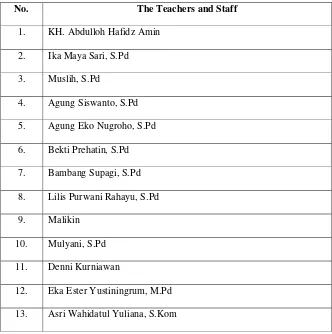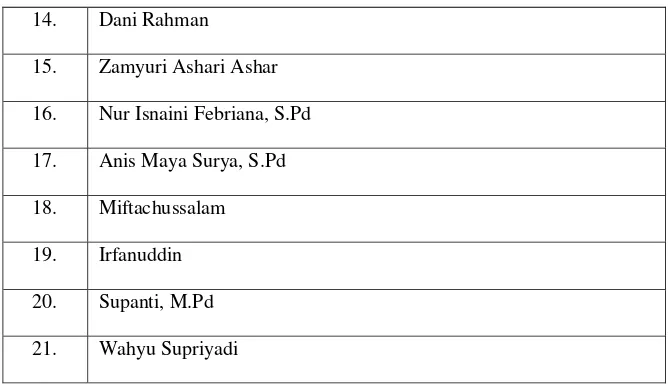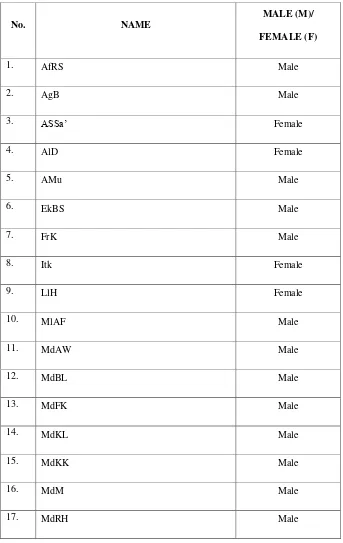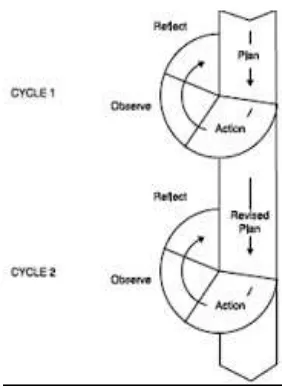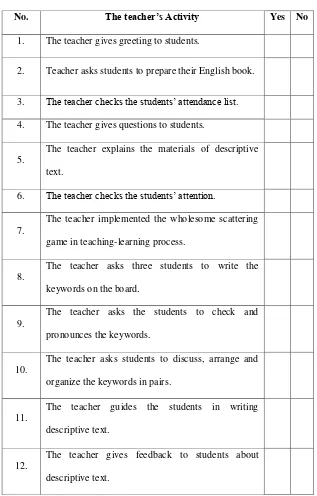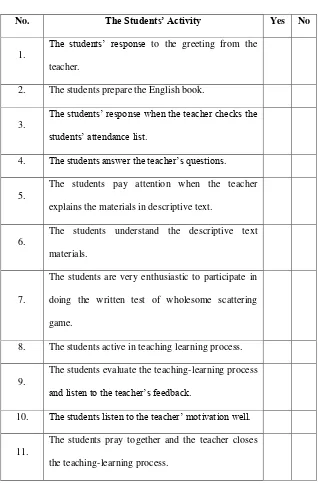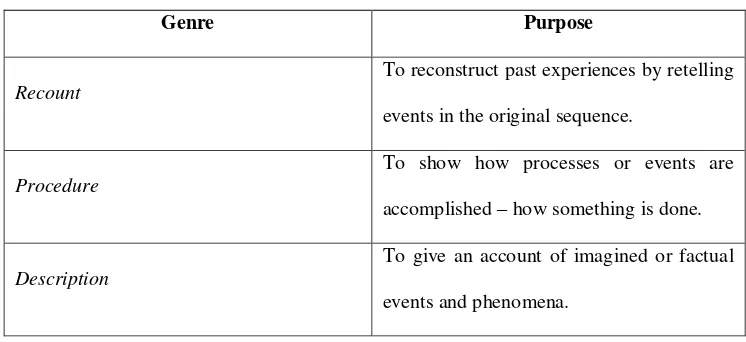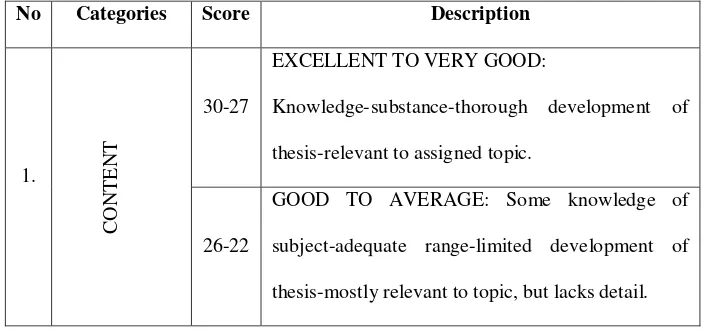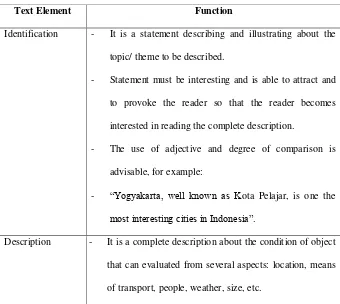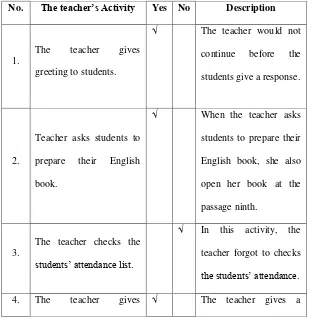i
IMPROVING STUDENTS‟ WRITING SKILLS THROUGH
WHOLESOME SCATTERING GAME OF THE EIGHTH GRADE
STUDENTS OF SMP “PLUS” ASSYAFA‟AH KARANGGEDE IN
THE ACADEMIC YEAR OF 2018/2019
A GRADUATING PAPER
Submitted to the Board of Examiners as a Partial Fulfilment of the Requirement
for the Degree of Sarjana Pendidikan (S.Pd.)
By:
Ni‟matul Maula
NIM.11314146
ENGLISH EDUCATION DEPARTMENT
TEACHER TRAINING AND EDUCATION FACULTY
STATE INSTITUTE FOR ISLAMIC STUDIES (IAIN)
▸ Baca selengkapnya: my teacher … new book yesterday
(2)ii
DECLARATION
In the name of Allah, The most Gracious and the most Merciful.
Hereby, the writer declares that this graduating paper is written by the
researcher. This paper does not contain any materials which have been published by
another people and it does not cite any other people‘s ideas except the information
from the references.
The researcher is capable to account her graduating paper if in future it can be
proved of containing others‘ idea or in fact that the researcher imitates the others‘
graduating paper. Likewise, this declaration is written by the researcher, and she
hopes that this declaration can be understood. The researcher will also agree if the
v MOTTO
“LA TAHZAN INNALLAHA MA‟ANA”
“Don‟t be sad. Allah is with us”
vi
DEDICATION
This graduating paper is dedicated to:
1. My lord, Allah SWT and Prophet Muhammad SAW Thank to Allah for gives
me guidance and strength in my life, especially to finish this graduating paper.
2. My beloved parent and my brother, who always prays guidance and motivate
me. You are the best for me.
3. My big family who always support for my education and finishing this
graduating paper.
4. My Islamic teacher, KH. Zoemri RWS (Alm) and Hj. Lathifah Zoemri RWS,
who always prays and support me. Thanks for everything. You are my parents
in this country.
5. All of my friends in PPTI Al Falah, your smile and support is my happiness
and my spirit in finishing this graduating paper.
6. And everyone who always help and supported me to finish this graduating
vii
ACKNOWLEDGEMENT
Bismillahirrahmanirrahim,
In the name of Allah, the most gracious and the most merciful, the king of
universe and space. Thank you to Allah because the writer can complete this
graduating paper as one of requirement to finish the study in English Department of
States for Institute Islamic Studies Salatiga.
This graduating paper would not have been complete without support,
guidance and help from individual and institution. Therefore, I would like to express
special thanks to:
1. Dr. Rahmat Hariyadi, M.Pd., as the Rector of States for Institute Islamic
Studies (IAIN) Salatiga.
2. Suwardi, M. Pd, as the Dean of the Teacher Training and Education Faculty.
3. Noor Malihah, Ph. D, as the Head of English Language Teaching Department
of States for Institute Islamic Studies (IAIN) Salatiga.
4. Dr. Ruwandi, S.Pd., M.A as the counsellor who has supported, motivated, and
given the researcher advices and suggestion from beginning until the end of
this graduating paper.
5. Lectures in the English Language Teaching Department who have given much
knowledge, the writer deeply thanks to you all.
6. Staffs who have helped the writer in processing of graduating paper
viii
7. My friends in PPTI Al Falah Salatiga, your smiling and supporting is my
motivation to finishing this graduating paper.
8. My friends of English Education Department. Thanks for your friendship and
kindness.
9. The eighth grade students of SMP ‗Plus‘ Assyafa‘ah Karanggede who as participant in this research.
10.The teachers of SMP ‗Plus‘ Assyafa‘ah Karanggede which also participate in this researcher.
Eventually, the graduating paper is expected to be able to provide useful
knowledge and information to the readers. The writer is pleased to accept
more suggestion and contribution for the improvement of this graduating
paper.
Salatiga, September 10th 2018 The Researcher
Ni‘matul Maula
ix ABSTRACT
Maula, Ni‘matul. 2018. Improving Students’ Writing Skills through Wholesome
Scattering Game of the Eighth Grade Students of SMP ‘Plus’
Assyafa’ah Karanggede in the Academic Year of 2018/2019. A Graduating Paper. English Educational Department. Teacher Training and Education of Faculty. State Institute for Islamic Studies of Salatiga. Counsellor: Dr. Ruwandi, S.Pd., M.A.
The research is mainly aimed to improve students‘ writing skills through wholesome scattering game of the eighth grade students of SMP ‗Plus‘ Assyafa‘ah
Karanggede in the academic year of 2018/2019. The subject of this research was 20 students in VIII class. The objective of the study are: (1) To describe wholesome scattering game can improve students‘ writing skills of the eighth grade students of
SMP ―Plus‖ Assyafa‘ah Karanggede in the academic year of 2018/2019. (2) To
describe how wholesome scattering game significantly improve students‘ writing
skills of the eighth grade students of SMP ―Plus‖ Asyafa‘ah Karanggede in the
academic year of 2018/2019. The methodology of research was classroom action research. It was conducted in 2 cycles which consists of planning, action, observation, and reflection in every cycle. The technique of collecting data was the observation to
find out the teacher‘s and students‘ activity during implementation wholesome
scattering game in the classroom. The second was written a test to find out the
students‘ writing skills in descriptive text. The last one was documentation to find out
the data which correlated with the research. The writer found there were improvement
in students‘ writing skills through wholesome scattering game, especially in descriptive text. The result of the research was successful. It was shown from the test of the first cycle and the second cycle which was higher than the table. The t-table was 2.09 and the t-test was 5.99. The mean score of post-test was higher than the mean score of pre-test, (63.3 and 50.6). Besides that, the mean score of post-test in the second cycle was higher than the mean score of pre-test (78 and 66.15). While the score of t-test was 7.09. The improvement of students‘ writing skills was significant. It can be seen from the number of the students who passed the passing grade in two cycles. The passing grade was 75. The students who passed the passing grade of test in the first cycle was 5% and the post-test was 25%. While the pre-test in the second cycle was 45% and post-pre-test was 75%. The data showed that the result of the t-test in the first cycle and the second cycle was higher than t-table. It means that the implementation of wholesome scattering game is successful to
x
TABLE OF CONTENT
TITLE ... i
DECLARATION ... ii
ATTENTIVE COUNSELOR‘S NOTE ... iii
CERTIFICATION PAGE ... iv
MOTTO...v
DEDICATION ... vi
ACKNOWLEDGEMENT ... vii
ABSTRACT ... ix
TABLE OF CONTENT ...x
LIST OF FIGURES... xiii
LIST OF THE TABLES ... xiv
CHAPTER I: INTRODUCTION A. Background of the Research ...1
B. Problem statements ...3
C. Objective of the Research ...4
D. Limitation of the Research ...4
E. Significant of the Research ...4
F. Hypothesis and Success Indicator ...5
G. Research Methodology...6
xi
2. Research Setting ...8
3. Research Subject ...14
4. Research Procedure ...15
5. Technique of Data Collecting ...18
6. Instrument of Research...19
7. Technique of Data Analysis ...23
F. Graduating Paper Outline ...26
CHAPTER II: THE THEORITICAL FRAMWORK A. Previous Research ...27
B. Writing ...29
1. Definition of Writing ...29
2. The Purpose of Writing ...31
3. Process of Writing ...31
4. Genre of Writing Text ...34
5. Assessment of Writing ...35
6. The Teachers‘ Role in Writing ...40
C. Wholesome Scattering Game ...42
1. Definition of Game...42
2. Wholesome Scattering Game ...43
D. Descriptive Text ...45
1. Definition of Descriptive Text ...45
xii
3. Types of Descriptive Text ...46
4. Language Features of Descriptive Text ...48
5. Generic Structure of Descriptive Text ...50
E. Minimum Completeness Criteria (KKM) ...52
CHAPTER III: IMPLEMENTATION OF RESEARCH A. Cycle I ...54
B. Cycle II ...70
CHAPTER IV: RESEARCH DATA ANALYSIS AND DISCUSSION A. Data Analysis ...86
B. Discussion ...101
CHAPTER V: CLOSURE A. Conclusions ...103
B. Suggestion ...105
REFERENCES APPENDIXES
xiii
LIST OF FIGURE
xiv
LIST OF TABLE
TABLE 1.1 List of the Teachers and Staffs ... 12
TABLE 1.2 List of the Research Activity... 13
TABLE 1.3 List the Member of the Eighth Grade Students in SMP „Plus‟ Asyyafaah Karanggede in the academic year of 2018/2019 ... 15
TABLE 1.4 The Teacher‟s Observational Sheet ... 20
TABLE 1.5 The Students‟ Observational Sheet ... 21
TABLE 2.6 Some Factual Genres ... 34
TABLE 2.7 The Rating Scale of Scoring in Writing ... 37
TABLE 2.8 Generic Structure of Descriptive Text ... 51
TABLE 3.9 Form the Result of Teacher‟s Observational Sheet in Cycle I ... ... 63
TABLE 3.10 Form the Result of Students‟ Observational Sheet in Cycle I ... 66
TABLE 3.11 Form the Result of Teacher Observational Sheet in Cycle II ... 79
TABLE 3.12 Form the Result of Students‟ Observational Sheet in Cycle II ... 81
TABLE 4.13 The Score of Students‟ Pre-test in Cycle I ... 86
xv
TABLE 4.15 The Standard Deviation of Pre-test and Post-test in Cycle I ... 90 TABLE 4. 16 The Score of Students‟ Pre-test in Cycle II ... 93 TABLE 4.17 The Score of Students‟ Post-test in Cycle II ... 95 TABLE 4.18 The Students‟ Standard Deviation of Pre-test and Post-test in
1 CHAPTER I INTRODUCTION
In this chapter, the researcher discusses the introduction of the study. This
chapter consists of eight parts. They are the background of the study, problem
statements, the objectives of the research, limitation of the research, the significance
of the research, hypothesis and success indicator, research methodology, and
graduating paper outline.
A. Background of the Study
Writing is thinking process, because writing is a process of putting
ideas down on paper transform thought into words and given them structure
coherent organization (Brown, 2001, in Fitri et al., 2017: 2-3). As we know
that writing is one of the skills which must measure some aspect of writing
before we write, such as the organization, generic structure, language features,
and others. Therefore, writing is the most significant skill which must be
taught. On the other hand, students are interest in the active learning, it will
create the learning environment exciting. Thus, the material can be
accomplished and understood by the students deeply. There are needed the
effective strategy in teaching writing skill to get what the learning aimed.
Talak-Kiryk (2010: 4) in Wulandari (2016: 145) states that games are
fun activities that promote interaction, thinking, learning, and
2
scattering game which is one of the games that can be motivated by the
students to improve their writing skill, especially in descriptive text. The
implementation of wholesome scattering game is the three students will be
asked to write vocabularies which are dictated by the teachers on the board in
unusual shape. Both the teacher and students will correct the letter together
and the students will imitate what the teacher spelling of the vocabularies. The
students will discuss in a group. They will arrange and organize the
vocabularies to be a descriptive text. At least, the students present their task in
front of the class. After that, the teacher will give a feedback on the
teaching-learning process.
Seeing in the fact, according to the interview with English teacher in
SMP ―Plus‖ Assyafa‘ah Karanggede, she faced the problems of the language
teaching process in the eighth grade students. The students have less skill in
four aspects of English, especially writing skill. They not understand yet
about the spelling of words. So, they confused about how to write the English
vocabulary clearly and correctly. It can be measured from the students‘ written task score and the students‘ written exercise in the classroom.
Therefore, the teacher usually implemented imitation strategy in previous of
English teaching-learning. Method and technique of teaching are conditional
based on the materials which would be tough. Besides that, the students‘
response to English subject also is less enthusiastic. So, the researcher
3
writing class. The researcher believe that it can improve the students‘ writing
skills. The students can know how to write and spell the keywords correctly
after implementing wholesome scattering game. Besides that, they also know
and understand the meaning of keywords. Then, they can produce many
sentences using the keywords. They will imagine and predict the content of
text about. So, the students can arrange and organize the sentences into a text.
Finally, both the teacher and the researcher make an agreement to
implementing wholesome scattering game in improve students‘ writing skill.
Based on the problems above, the researcher is very interested in
propose a study entitled, ―IMPROVING STUDENTS‘ WRITING SKILLS
THROUGH WHOLESOME SCATTERING GAME OF THE EIGHTH
GRADE STUDENTS OF SMP ―PLUS‖ ASSYAFA‘AH KARANGGEDE IN
THE ACADEMIC YEAR OF 2018/2019‖.
B. Problem Statements
Based on the phenomenon above, the researcher would like to arrange
the problem as follows:
1. How can wholesome scattering game improve students‘ writing skills
of the eighth grade students of SMP ―Plus‖ Assyafa‘ah Karanggede in
the academic year of 2018/2019?
2. How significant can wholesome scattering game improve students‘
writing skills of the eighth grade students of SMP ―Plus‖ Asyafa‘ah
4 C. The objectives of the Research
Based on the statement in the problem of the study, the objectives of
the study are:
1. To describe wholesome scattering game improve students‘ writing skills of the eighth grade students of SMP ―Plus‖ Assyafa‘ah Karanggede in the academic year of 2018/2019.
2. To describe how significant wholesome scattering game significantly
improve students‘ writing skills of the eighth grade students of SMP ―Plus‖ Assyafa‘ah Karanggede in the academic year of 2018/2019.
D. Limitation of the Research
In this research, researcher limits the material of the study on
descriptive text in improving students‘ writing skills through wholesome scattering game of the eighth grade students of SMP ―Plus‖ Assyafa‘ah Karanggede in the academic year of 2018/2019. It‘s a purpose to avoid the
whole discussion of this research.
E. Significance of the Research
In this graduating paper, the researcher hopes that it‘s can give the
advantages to the reader. This research is expected to give theoretically and
5
1. Theoretically
a. The result of research can be used as the reference for those who want
to conduct a research in English teaching to build students‘
achievement of writing skills.
b. This research will be useful for the teacher in English teaching.
2. Practically
a. For the researcher
The finding of the research can be used as a starting point for
the researcher to get experiences that will be useful in the future as an
English teacher.
b. For English Teacher
This research can be used as a consideration in selecting of
effective English teaching in future.
c. For Students
This research can motivate the students to improve their
writing skill in English learning.
F. Hypothesis and Success Indicator
Based on the interview of an English teacher in SMP ―Plus‖ Assyafa‘ah Karanggede, which are described in chapter I, that there are
problems in English teaching-learning, especially writing class. Therefore, the
researcher tries to overcome those problems by implementing Wholesome
6
research, the researcher proposes a hypothesis: ―Implementing Wholesome Scattering Game can improve students‘ writing skills‖.
The success indicator of this research is taken from the students‘ skills
shown in Lesson Plan. The students‘ success in doing the activities in the
cycle I and cycle II which will be assessed by referring to the criterion of
Minimum Completeness Criteria (KKM). The Minimum Completeness
Criteria of English subject (KKM) in the SMP ―Plus‖ Assyafa‘ah Karanggede
is 75. The researcher expects that there are at least 75% of the students who
pass the Minimum Completeness Criteria (KKM).
G. Research Methodology 1. Method of Research
According to Nunan (1991: 3) stated that an important aspect
of methodology is the development of teaching routines, materials, and
tasks in the classroom. In addition, McNiff (2002: 6) in Vaccarino et al
(2006: 7) mentioned that ―action research‖ refers to ―a practical way of
looking on your own work to check that it is as you would like it to
be‖. In addition, McKay (2006: 16) describing the same idea about
action research, as follows:
―Action research begins with teacher identifying a concrete
problem they have. They then gather data to help solve the problem and, after carefully analysing this data, undertake changes in their classroom to helpfully solve their initial
7
According to Khasinah (2013: 113) explained that classroom
action research is a method of finding out what works best in own
classroom so that teacher can improve students learning. According to
Burns (2010: 2) stated that the central idea of the action part of Action
Research is to intervene in deliberate way in the problematic situation
in order to bring about changes and, even better, improvement in
practice. On the one hand, Borg, Gall, and Gall (1993: 391) in
Khasinah‘s journal (2013: 109) that state five purposes of classroom
action research. They are:
a. It supports the professional development of practitioners by
helping them become more competent in understanding and
utilizing research finding and carrying out research themselves
when appropriate.
b. It builds a collegial networking system for sometimes it involves
several educators, even students and parents, working together.
c. It helps practitioners identify problem and seek solution in a
systematic fashion.
d. It can be used at all levels and in all areas of education, such as a
mean of in-service training for principals.
In this research, the researcher used classroom action research
that does a treatment in every cycle, the cycle I and the cycle II. It is
8
Besides that, it is appropriate to implement of the eighth grade
students of SMP ‗Plus‘ Assyafa‘ah Karanggede.
2. Research Setting
a. General Situation of SMP “Plus” Assyafa‟ah Karanggede
The research was conducted in SMP ―Plus‖ Assyafa‘ah, in the
academic year of 2018/2019 which is located at Dk. Klencong Rt.
02/01 Pengkol Karanggede Boyolali. It is one of the Islamic
Boarding Home Darul Abror Institution which used full-time activity
of teaching and learning process. Arabic and English are learned
intensively which is supported by the professional staff and
conducive environment. SMP ―Plus‖ Assyafa‘ah Karanggede have been combining of the three curriculum as the educational reference.
They are:
1) Salafiyah boarding home
2) Modern boarding home
3) The Ministry of Education and Culture (KEMENDIKBUD)
On the other hand, it has been giving two of the special quality
program as follows:
1) Special Quality of Kitab Kuning
The learners are expected, to be able to read and
understand the Kitab Kuning correctly and clearly with the
9
2) Special Quality of English
The learners expected to have English speaking skill which
can support the learners‘ achievement in the next educational
level.
Then, the more general information of the school described as
follows:
Name of School : SMP ―Plus‖ Assyafa‘ah Karanggede Address : Dk. Klencong Rt. 02/01 Pengkol,
Karanggede, Boyolali
Village : Pengkol
Subdistrict : Karanggede
Regency : Boyolali
Pos Code : 57381
Website : www.darulabror.com
Email : smpplus.assyafaah@yahoo.com
Phone : 081326517925
Headmaster : Lilis Purwani Rahayu, S. Pd
b. Vision and Mission of SMP “Plus” Assyafa‟ah Karanggede Vision
According to the location and the basic foundation of SMP
10
“The realization of the graduate who is sholeh, intelligent,
independent, responsible and able to play a role in society.”
Explanation:
Sholeh, it means that they have to live based on the teaching of Islam.
Intelligent, it means that the graduate‘s students of SMP ―Plus‖ Assyafa‘ah had
Independent, they had a thought, sense, and attitude appropriately with the region and nation.
Responsible, the students can create a better alteration of their self.
Play a role in society, the students had a thought, sense, and attitude bravely as the rightness.
Mission
Based on the Visi above, SMP ―Plus‖ Assyafa‘ah Karanggede
implement the mission as follows:
1) Create the students‘ graduate who is Soleh, which have an achievement (academic and non-academic), independent, and is
able to play a role in society.
2) Create the quality curriculum, they are holistic, according to the
11
3) Create a dynamic, creative, innovative, and a fun condition of
teaching-learning process which used the CTL approach.
4) Crate the educational facilities, and quantity and quality.
5) Create the human resources (SDM), educators, and educational
system which had professional, responsible, and had the high
dedication.
6) Create the school management which based on the concept of the
Base School Management (Manajemen Berbasis Sekolah).
7) A defrayal create education which is available.
8) Create the whole assessment, authentic, objective, and continued,
which be able to measure the whole students‘ competence.
c. The situation and Condition of Educational Facilities
In order to support of teaching-learning process, the students
need facilities in the school. Therefore, it is important to be a priority
in the school educational system. The facilities which are given in
SMP ―Plus‖ Assyafaah are:
1) Headmaster‘s Room : 1 2) Administration room : 1
3) Teachers‘ Room : 1
4) Library Room : 1
5) Lab Room. Computers : 1
12
7) Dormitory Room : 2
8) Master‘s Wc : 1
9) Students‘ Wc : 2
d. The Situation of the Teachers and Staff
The teachers are the main component in education which have
been taught, educate and give the knowledge to students. It is aimed
they can understand the material well. The teachers and staffs which
participate in SMP ―Plus‖ Assyafaah Karanggede, as follows:
Table. 1.1. List of the Teachers and Staffs.
No. The Teachers and Staff
1. KH. Abdulloh Hafidz Amin 2. Ika Maya Sari, S.Pd 3. Muslih, S.Pd
4. Agung Siswanto, S.Pd 5. Agung Eko Nugroho, S.Pd 6. Bekti Prehatin, S.Pd 7. Bambang Supagi, S.Pd 8. Lilis Purwani Rahayu, S.Pd 9. Malikin
10. Mulyani, S.Pd 11. Denni Kurniawan
13 14. Dani Rahman
15. Zamyuri Ashari Ashar 16. Nur Isnaini Febriana, S.Pd 17. Anis Maya Surya, S.Pd 18. Miftachussalam 19. Irfanuddin 20. Supanti, M.Pd 21. Wahyu Supriyadi
e. The Setting of Time
The process of this research are continued of the research
planning up to research implementation. The schedule of this research
are:
Table 1.2. List of the Research Activity.
No. Date and Time Activities Place
14
Karanggede.
- Interview about the students‘ problem
with the English teacher of SMP ―Plus‖ Assyafa‘ah
Karanggede.
3. August, 14th 2018 - Meet up with the teacher English to discuss the lesson plan (RPP).
The teacher office of SMP ‗Plus‘
Assyafa;ah Karanggede. 4. August, 21th 2018 Research cycle I Eighth-grade
classroom 5. August, 25th 2018 Research cycle II Eighth-grade
classroom.
3. Research Subject
The subject of the research was the students of SMP ―Plus‖ Assyafa‘ah Karanggede in the academic year of 2018/2019. The
researcher focuses on the eighth grade students because the material
taught exactly in that level class. Thus, it supported in applying of this
research. The students consist of twenty students that were thirteen male
15
Table 1.3. List the Member of the Eighth Grade Students in SMP “Plus” Assyafaah
Karanggede in the academic year of 2018/2019
No. NAME
MALE (M)/
FEMALE (F)
1. AfRS Male
2. AgB Male
3. ASSa‘ Female
4. AlD Female
5. AMu Male
6. EkBS Male
7. FrK Male
8. Itk Female
9. LlH Female
10. MlAF Male
11. MdAW Male
12. MdBL Male
13. MdFK Male
14. MdKL Male
15. MdKK Male
16. MdM Male
16
18. SiNC Female
19. TiMA Female
20. ZuF Female
4. Research Procedure
According to Kemmis and McTaggart (1988), which are cites by
Burns (2010: 7-9), that there are four stages in the cycle of action research.
The stages of action research are planning, action, observation, and
refection, as explained later:
a. Planning
In this phase, the researcher identifies a problem or issue and develop
a plan of action in order to bring improvements in a specific area of
the research context.
b. Action
The plan is a carefully considered one which involves some deliberate
interventions in the researcher‘s teaching situation that the researcher
put into action an agreed period of time.
c. Observation
In this phase, the researcher involves systematically the effects of the
action and documenting the context, actions, and opinions of those
17
d. Reflection
At this section, researcher evaluates and describe the effect of the
action in order to make sense of what has happened and to understand
the issue the researcher explored more clearly.
It will be continued from cycle I until that be achieved the clear
result of research. The stages of action research can be imagined as
follows:
Figure. 1.1 Kemmis‟ action research model (cited in Burns, 2010: 9).
In this research, the researcher used four stages in research
procedure which are consists of planning, action (implementation of
wholesome scattering game), observation, and reflection. Those stages are
18 5. Technique of Data Collecting
Altrichter et al (1993: 77) in Somekh (2006: 11) states that the
data collected at this stage were used to identify problems and
hypothesize solutions based on the theoretical insight that could be tasted
by planning and implementing action strategy. In this research, the
researcher used some techniques in data collection. They are:
a. Observation
Observation will be used as long as teaching-learning activity
since the cycle I. It is aimed to know and appraised the activity and
condition of the research subject. The researcher used the students‘ observational sheet which is consist of students‘ answered greeting
the teacher, students‘ attendance, the students‘ attention, students‘
interest of the wholesome scattering game activity, etc.
b. Test
A test is a set of questions, each of which has a correct answer,
that examines usually answer orally or in writing (Ebel & Frisbie,
1991: 26). On beside that, Heaton (1988: 5) cites that tests may be
constructed primarily as devices to reinforce learning and motivate
the student or primarily as a means of assessing the student‘s
performance in the language. In this research researcher used pre-test
and post-test to measure the students‘ achievement in writing skill of
19
the treatment. The Pre-test is done before implemented of the
wholesome scattering game in the classroom. Whereas, a post-test is
implemented after the wholesome scattering game.
c. Documentation
The last technique of collecting data in this research is
documentation that searches the data which correlated with this
research. They are a field note, book, photos, video, etc. Therefore,
the researcher can know the condition and activity of teacher and
students as long as the teaching-learning process.
6. Instrument of Research
Based on the technique of data collecting, the researcher used
some research instrument. They are:
a. The teacher‘s and students‘ observational sheets
The instrument that used in this observation is an
observational sheet, which is consist of the teacher‘s and students‘ observational sheet. The teacher‘s and students‘ observational sheet
are a tool to observe the activities of implementing the wholesome
scattering game in the classroom. The teacher‘s sheet is used to observe the teacher‘s activities. Besides that, the students‘ sheet is as
20
observed which is the researcher can know and see clearly what the
teacher and students doing in the classroom.
Table. 1.4 The teacher‟s observational sheet
No. The teacher‟s Activity Yes No
1. The teacher gives greeting to students.
2. Teacher asks students to prepare their English book.
3. The teacher checks the students‘ attendance list. 4. The teacher gives questions to students.
5.
The teacher explains the materials of descriptive text.
6. The teacher checks the students‘ attention.
7.
The teacher implemented the wholesome scattering game in teaching-learning process.
8.
The teacher asks three students to write the keywords on the board.
9.
The teacher asks the students to check and pronounces the keywords.
10.
The teacher asks students to discuss, arrange and organize the keywords in pairs.
21 13.
The teacher and students pray together in closing the teaching-learning process.
Table. 1.5 The students‟ observational sheet
No. The Students‟ Activity Yes No
1.
The students‘ response to the greeting from the
teacher.
2. The students prepare the English book.
3.
The students‘ response when the teacher checks the
students‘ attendance list.
4. The students answer the teacher‘s questions.
5.
The students pay attention when the teacher explains the materials in descriptive text.
6.
The students understand the descriptive text materials.
7.
The students are very enthusiastic to participate in doing the written test of wholesome scattering game.
8. The students active in teaching learning process.
9.
The students evaluate the teaching-learning process and listen to the teacher‘s feedback.
10. The students listen to the teacher‘ motivation well.
11.
22
b. Test Items
In this research, the test item is as a tool that used to measure
the students‘ writing skill. The form of instrument is written, pre-test
and post-test. They are applied before and after a treatment. The
imaged of test items of pre-test in the first cycle, as follows:
Please understand the instructions below!
1) Choose one of the topics below!
a) The Prambanan temple.
b) My school.
c) The ceremony on 17th August.
2) Describe in the simple paragraph!
The test items of post-test in the first cycle is imaged:
Please read the vocabularies below!
Please read and follow the instruction below!
1) Choose the correct vocabularies above!
2) Arrange and organize into the simple description text
(consist of 6 up to 8 sentences) about ―My House‖!
3) Use the simple present tense formula!
4) Make sure your text should consist of identification and
23
c. The instrument of documentation.
Some of the instrument in documentation are photos, videos,
field notes, the syllable validity, the lesson plan validity.
d. Interview
The researcher used 5W + 1 H in the interview of English
teacher in the implementation of wholesome scattering game.
7. Technique of Data Analysis
a. Descriptive Technique (Qualitative)
A descriptive technique is used by the researcher in order to
analyze the students‘ motivation, interest, and behavior during the
teaching-learning process. This technique is supported by the
researcher observational sheet.
b. Statistical Technique (Quantitative)
1) Mean
According to Ebel & Frisbie (1991:60), the mean is the
average score, obtained by summing all the scores and dividing
that sum by the total of scores. The formula of the mean can be
represented as follows (Hadi, 1981: 246-258):
∑
Explanation:
24
∑ X = Total of individual scores (the sum of the scores)
N = Number of students
2) Difference calculation of the mean
∑
Explanation :
MD = Different of mean
∑D = Sum of difference between pre-test and post-test.
N = Total number of students.
3) Standard Deviation
The formula of standard deviation is:
√∑ (∑ )
Explanation:
SD = Standard Deviation for one sample test.
D = Difference between pre-test and post-test.
25
4) Calculation of t-test
|∑ | |
√ |
Explanation:
t = t-test for the differences between pre-test and post-test.
SD = Standard Deviation for one sample t-test.
D = Differences between pre-test and post-test.
N = Total number of sample.
5) To calculate the standard error for the mean difference, the
researcher used the formula as follows:
= √
Explanation:
SEMD = The standard error for the mean difference.
SDD = Standard Deviation
N = The total number of the research
d.f = N-1
6) To calculate the T-test the researcher used the formula as follows:
Explanation:
26
MD = Mean of difference.
SEMD = The standard error for the mean difference.
H. Graduating Paper Outline
This graduating paper is divided into five chapter. Chapter one is
discuss the Introduction, which consists of the Background of the Study,
Problem Statements, the Objective of the Research, Limitation of the
Research, Significance of the Research, Hypothesis and Success Indicator,
and Research Methodology. In the Research Methodology will be explained
about Method of Research, Research Setting, Research Subject, Research
Procedure, the Technique of Data Collecting, Instrument of the Research,
Technique of Data Analysis. The last one in this chapter is graduating paper
outline. Chapter two describe the theoretical framework, which is consists of
the Previous Research, and the Theories that Related to and Support the
Research. Chapter three is the Research Implementation which are consist of
the description of the first cycle (Planning, Implementing of Wholesome
Scattering Game, Observation, Reflection), and the description of the second
cycle (Planning, Implementing of Wholesome Scattering Game, Observation,
Reflection). Chapter four is the Research Data Analysis of Data Interpretation
that discusses the result of the test. Chapter five is Closure, which is consist of
27 CHAPTER II
THE THEORETICAL FRAMEWORK
In this chapter, the researcher writes the theories that have a correlation with this
research. They consist of previous research, writing skill, the genre of the text,
wholesome scattering game, and descriptive text.
A. Previous Research
The first research is entitled ―Improving Students’ Ability in Writing
Descriptive Text Through ‘Wholesome Scattering Game’ (A classroom action
research with the eighth grade students of MTs Patean Kendal in academic
year 2010/2011)‖. The research was written by Hami Widodo that is a student of education faculty, Walisongo state institute for Islamic studies, Semarang.
This research is classroom action research that was done in two cycles, the
first cycle used wholesome scattering game as a media in teaching descriptive
text, the researcher of that research asked the students to describe their best
friend in the class using keywords had been given by the researcher of that
research. On the other hand, the score of the students‘ writing was 50.7 with
the total score of 1570 in the first cycle. Whereas the second cycle, the
researcher of that research asked students to describe beach which the score of
students‘ writing was 67.6 with the total score of 2095. The result of that
result showed that the students had improvement of their ability in writing
28
The second research is entitled ―Improving the Ability in Writing
Descriptive Text of the Seventh Grade Students of MTs Miftahul Falah Kayen
Pati in Academic Year 2013/2014 by Using Wholesome Scattering Game‖. The research was written by Novi Khumaerotul Hidayah which was one of the
students in Universitas Muria Kudus. The research design was classroom
action research. The research subject is the seventh-grade students‘ A of MTs Miftahul Falah Kayen Pati which consist of twenty-two students. The
researcher did this research in two cycles, the cycle I and the cycle II. The
students‘ average score of pre-test in writing descriptive text is 59.13%. While
the post-test of cycle I indicated that the students‘ average score in writing
descriptive text is 76.77%. In the cycle II, the students‘ average score is 83.54%. So, it can be concluded that there is an improvement of the students‘
writing ability in descriptive text in every cycle. On the besides that, the
classroom environment is more effective and the students are better
confidence, braver, and it creates a fun teaching-learning.
The third research is entitled ―Improving Students Ability in Writing
Procedure Text Through Wholesome Scattering Game of Tenth Grade Student
of SMA Muhammadiyah Kudus in Academic Year 2016/2017‖. This research was written by Adha Umi Haryanti which is one of the students in Universitas
Muara Kudus. The design of the research was classroom action research
which was done in two cycles. Every cycle consists of four stages: planning,
29
data that are observation sheet and written test, the implementation of
wholesome scattering game can improve the students‘ ability in procedure text. They could easily without consuming more time because they were
arranging and writing procedure text based on the key-words. It can be seen
from the improvement score of the cycle I and cycle II. The average of the
cycle I is 75% and the average score is 69.9. Fire while in cycle II the average
is 78% and the students‘ average score improved.
Based on some of the previous study above, there are differences
between this research and the others previous research, as mentioned. The
first and second research is most relevant with this research which is about the
improvement of students‘ writing through wholesome scattering game. The
differences between each other are the research subject, the data collection,
and the specific material. The last one, the differences of the third research are
the subject and the material which was given, it is a procedure text. While, the
material in this research is descriptive text.
B. Writing
1. Definition of Writing
Writing is widely used within foreign language courses as a
convenient means for engaging with aspects of language other than the
writing itself (Ur, 1991: 162). Therefore, writing is very important to teach
by the educator. It has to pass many stages to produce a good written. One
30
text in order to the arrangement of the paragraph will not out of the topics
sentences.
Writing is an extreme act of attention and memory; it pleads with
your brain cells to make a new connection (Morley 2007: 8). On the other
word, it needs a hard and smart work of thinking in the process of learning
writing skill. This occurs the students‘ assumption that learning writing
skill is very hard to learn. It is one of the difficulties for them. In addition,
the teacher applies inactive learning, so the students are bored and they
need a motivation to attend enthusiastically the learning process. Indeed,
there are theifferent reason for writing in the foreign language classroom,
as explained more of Wright et al (2006:58), they are:
a. We can see, very readily, the learners‘ proficiency level: what language items the learners can use correctly and what
mistakes they make. This is the traditional and still useful role
for writing.
b. Many who are visual learners need to write in order to engage
their way of learning … they need to see the language. Writing
with this purpose means that it is relevant even for learners
who take no written examinations.
c. Learners can be made aware of the many different purposes
31
Writing is one of the skills that need an understanding of grammar
and vocabularies mastery. It is aimed to produce the sentences or a text
effectively and well.
2. The purpose of Writing
According to Ur (1991: 163) the purpose of writing, in principle, is
the expression of ideas, the conveying of message to the reader; so the
ideas themselves should arguably be seen as the most important aspect of
the writing Difficulties of Writing. Since this will affect what language
they choose and how they use it (Harmer, 2004: 15). In addition, writing
skills provide step-by-step instruction in the foundational skills needed by
students to become good writers, including grammar, sentence structure,
paragraph composition, mechanics and usage, and transcription. Writing
skills help build fluency and confidence and provides a variety of
strategies and opportunities to apply them. It is ideal for differentiated
instruction and can serve as a comprehensive writing program is general
classrooms, inclusion classrooms, and specialized settings (EPS:2).
3. Process of Writing
As the explanation of a Hyland‘s book (2003: 10-13) that the
process approach to writing teaching emphasize the writer as an
independent producer of texts, but it goes further to address the issues of
what teacher should do to help learners perform a writing task. In addition,
32
only one. Process writing is a way of looking at what people do when they
compose written text. As we know that, there are some stages that will be
prepared. Harmer (2004: 4-5) cited that there are some stages in writing
skill as a follows:
a. Planning
Experienced writers plan want they are going to write. When
planning, writers have to think about three main issues. In the first
place, they have to consider the purpose of their writing since this will
influence (amongst other things) not only the type of the text they wish
to produce, but also the language they use, and the information they
choose to include. Secondly, experienced writers think of the audience
they are writing for, and also the choice of language, it is formal or
informal. Thirdly, writers have to consider the content structure of the
piece – that is, how best to sequence the fact, ideas, or arguments which they have decided to include.
b. Drafting
As the writing process proceeds into editing, a number of the
draft may be produced on the way to the final version.
c. Editing (Reflecting and Revising)
More skilled writers tend to look at issues of general meaning
and overall structure before concentrating on detailed features such as
33
are often helped by other readers (or editors) who comment and make
suggestions. Another reader‘s reaction to a piece of writing will help
the author to make appropriate revisions.
d. Final Version
Once writers have edited their draft, making the changes they
consider to be necessary, they produce their final version. This may
look considerably changed in the editing process. But the writer is now
ready to send the written text to its intended audience.
Brown (1991: 335-336) state some process approaches to writing
which are adapted from Shih (1986) as follows:
a. Focus on the process of writing that leads to the final written product.
b. Help student writes to understand their own composting process.
c. Help them to build repertoires of strategies for prewriting, drafting,
and rewriting.
d. Give students time to write and rewrite.
e. Place central importance on the process of revision.
f. Let students discover what they want to say as they write.
g. Give students feedback throughout the composing process (not just on
the final product) as they attempt to bring their expression closer to
intention.
34
i. Include individual conferences between teacher and student during the
process of composition.
In this research, the researcher focuses on the students‘ process and
product of the writing. It involves the teacher to explains and guided the
students in teaching-learning process. In order to the students understand
the component of writing and can write what their idea effectively and
organizing.
4. Genre of Writing Text
Hyland explained that genre is social processes because members of
a culture interact to achieve them; they are goal-oriented because they
have evolved to achieve things; and stage because meanings are made in
steps and it usually takes writers more than one step to reach their goals.
He mentioned some factual genres in his book, they are a recount,
procedure, description, report, and explanation (Hyland, 2003: 19-20).
Table. 2.6 Some Factual Genres
Genre Purpose
Recount
To reconstruct past experiences by retelling events in the original sequence.
Procedure
To show how processes or events are accomplished – how something is done.
Description
35 Report
To present factual information about a class of things, usually by classifying them and then describing their characteristics.
Explanation
To give reasons for a state of affairs or judgment.
Source: Buttet al., 2000; Martin, 1989.
One of the genres above will be tough in the teaching-learning
process of this research, descriptive text. It is about describing something,
person, event, or place. It explains the characteristic of the object.
5. Assessment of Writing
According to PDST (2013:36) stated as a follows:
―Assessment is the process of generating, gathering, recording,
interpreting, using and reporting evidence of learning in individuals, group or system, which relies upon a number of instruments, one of which may be a test. Educational assessment
provides information about progress in learning‖
(assessment in the primary school curriculum, Guidelines for school. NCCA, 2007, p. 4)
There are some criteria in the writing assessment which are needed
more attention by the teachers. According to Hamp-Lyons (1991b) in
Weigle‘s book (2002: 115) state that the assessment has had a positive
reception among students, faculty, advisor, and other community members
because it reflects the concerns of and is easily interpreted by these varied
36
assessment of learning English, assessment of the process and outcome of
learning English. The assessment of process is appraised during the
teaching-learning process such as the students‘ attendance, the students‘ active participation and creativity in solving the problems in the process of
learning, etc. Whereas, the assessment outcome of learning English is
about the students‘ competence in understanding the material which is
given.
Harris (1996) in fauziati et al. (2005: 73) mentioned the component
of writing ability as follows:
a. Content : the substance of the writing, the ideas expressed.
b. Form : the organization of the contents.
c. Grammar : the employment of the syntactical patterns.
d. Style : the choice of structure and lexical items to give a
particular flavor for the writing.
e. Mechanics: the use of the graphics convention.
In addition, JB. Heaton (1988: 135) cites that there are five
components for writing good prose. They are:
a. Language uses: the ability to write correct and appropriate
sentences;
b. Mechanical skills: the ability to use correctly those conventions
37
c. Treatment of content: the ability to think creatively and develop
thoughts, excluding all irrelevant information;
d. Stylistic skills: the ability to manipulate sentences and
paragraphs, and use language effectively;
e. Judgement skills: the ability to write in an appropriate manner
for particular audience in mind, together with an ability to select,
organise and order relevant information.
Based on the explained, there are necessary arrange the scales and
rating scales in order to be easier for the teacher in appraising the students‘
writing skills. According to Weigle, et al. (109-116) states that rating scale
is of critical importance for the validity of the assessment. In this research
researcher used scale which consists of five criterion of scoring writing
skills assessment, it is described as below:
Table. 2.7 The Rating Scale of Scoring in Writing
No Categories Score Description
1.
EXCELLENT TO VERY GOOD:
Knowledge-substance-thorough development of thesis-relevant to assigned topic.
26-22
38 21-17
FAIR TO POOR: Limited knowledge of subject-little substance-inadequate development of topic.
16-13
VERY POOR: Does not show knowledge of subject-non – substantive-not pertinent-OR not enough to evaluate.
EXCELENT TO VERY GOOD: Fluent expression-ideas clearly stated/ supported- succinct-well – organized-logical sequencing-cohesive.
17-14
GOOD TO AVERAGE: Somewhat copy-loosely organized but main ideas stand – out-limited supported-logical but incomplete sequencing.
13-10
FAIR TO POOR: Non – fluent-ideas confused or disconnected-lacks logical sequencing and development.
9-7
VERY POOR: Does not communicate-no organization-OR not enough to evaluate.
3.
EXCELENT TO VERY GOOD: Sophisticated range-effective word/idiom choice and usage-word form mastery-appropriate register.
17-14
GOOD TO AVERAGE: Adequate range-occasional errors of word/idiom from, choice, usage, but meaning not obscured.
13-10
39 9-7
FAIR POOR: Essentially translation-little knowledge of English vocabularies, idioms, word form-OR not enough to evaluate.
4. complex construction-few errors of agreement, tense, number, word/function, articles, pronouns, prepositions.
21-19
GOOD TO AVERAGE: Effective but simple construction-minor problems in complex constructions-several errors of agreement, tense, number, word order/function, articles, pronouns, prepositions but meaning seldom obscured.
18-11
FAIR TO POOR: Major problem in simple/complex construction-frequent errors of negation, agreement, tense, number, word order/function, articles, pronouns, prepositions and/or fragments, run – ons, deletions-meaning confused obscured.
10-5
VERY POOR: Virtually no mastery of sentence construction rules-dominated by errors-does not communicate-OR not enough to evaluate..
5.
EXCELENT TO VERY GOOD: Demonstrates mastery of conventions-few errors of spelling, punctuation, capitalization, paragraphing.
40
spelling, punctuation-capitalization, paragraphing, but meaning obscured.
3
FAIR TO POOR Frequent errors of spelling, punctuation-capitalization-paragraphing-poor handwriting-meaning confused or obscured.
2
VERY POOR: No mastery of conventions-dominated by errors of spelling, punctuation, capitalization, paragraphing—handwriting illegible-OR not enough to evaluate.
Jacob et al.’s (1981) scoring profile.
6. The Teachers‘ Role in Writing
Teaching is about teach and guidance the learners. Based on
explanation of Harmer (1998 :79) about one of the important reason of
teaching writing skill, as below:
Writing Skill: by far the most important reason for teaching special conventions (punctuation, paragraph construction etc.) just as they need to know how to pronounce spoken English appropriately. Part of our job is give them that skill.
Teaching writing is not about how to teach the learners write clearly
in their product. But it must understand deeply of teaching writing skill
process. Writing skill need to be explicitly taught (Welsh Assembly
41
everything we do in the classroom, the methods and materials we adopt,
the teaching style we assume, the task we assign, are guided by both
practical and theoretical knowledge, and our decisions can be more
effective if that knowledge explicit.
Teacher‘s roles can change from one task to another or from one
stage of an activity to another, and an ability to be flexible in moving
between roles can contribute to the success of a class (Hyland, 2003: 119).
In addition, Harmer (2001: 57-62) mentioned that there are eight roles of
teachers in the classroom. They are controller, organizer, assessor,
prompter, participant, resource, tutor, and the last is observer. All of them,
the teacher just has three effective roles in teaching writing subject, as
Harmer (2001: 261-262) explained:
a. Teacher as Motivator
The teacher will motivate the students where they are involved
in creative writing activity it is usually the case that some find it
easier to generate ideas than others.
b. Teacher as Resource
In this teachers‘ roles should be ready to supply information and
language where necessary.
c. Teacher as Feedback Provider
Teachers give feedback on writing task special care, where is
42
much to focus on based on what students need at this particular
stage of their studies, and on the tasks they have undertaken.
Based on explained, teachers should be a guide in teaching writing
and, on the contrary, students need more explanation what has to be
written and how they can write the sequences of ideas and can‘t come out of the topics. In this research, the teacher combined the three roles, as
explained, in the teaching writing process.
C. Wholesome Scattering Game
1. Definition of Game
Wright et al (2006 :2) state that games also help the teacher to
create context in which the language is useful and meaningful. The
learners want to take part, and in order to do so must understand what
others are saying or have written, and they must speak or write in order to
express their own point of view or give information. Games provide one
way of helping learners to experience language rather than merely study it.
Sigríður Dögg Sigurðardóttir (2010: 15) cites that games can be a
good way to prevent this because not only are games fun but they can
provide writers with a reason to write and it is obvious that writing will
become easier when there is a clear reason instead of just having to write
43
The game is used in order to improve students‘ motivation in the
writing class. Besides that, the students were not bored to participate in the
in writing teaching-learning process.
2. Wholesome Scattering Game
Wholesome scattering game is one technique that was put forward
by Natalie Hess in one of his book that entitled Headstarts. He (1991: 39)
explained that in this activity, students, on occasion not only predict the
content of the passage they are about to read, but also almost duplicate
sentences which actually appear in it. The first of implementing of this
technique is arranging the words in weird and unusual ways is fun and
takes a quite a while. The teacher has to prepare before conducting this
activity. It is about choosing twelve to sixteen keywords from the text
which will read in the class. Based on Hess cites that there is some
procedure for implementing wholesome scattering, as follows:
a. Ask three to five students to come to the board. Their task is to write
down words you dictate. (in a good class, ask a student to dictate).
Each student writes each word do that each word is written as many
times as there are students at the board. They scatter these words at
random all over the board, and try to arrange the words in unusual
ways. Some will be written horizontally, other vertically, others in
shapes, others upside down. Do not comment on spelling at this stage.
44
student next to them has spelt a word or as they are corrected by others
in the class.
b. While the students at the board are doing this, those their seats can
produce their own arrangements of the words either on paper or in
notebooks.
c. When you have finished dictating the words, the students who are at
the board return to their seats.
d. Ask if anyone in the class thinks they have produced a particularly
unusual arrangement of the words. If there are volunteers, ask them to
display their arrangements.
e. Go over the words on the board, eliciting correct spelling and
meaning.
f. Ask the students, in pairs, to write as many sentences as possible using
the words on the board. They should try to put more than one of the
words in each sentence. Tell them that they have only three minutes
for this.
g. Stop them when the time is up and ask pairs to tell you how many
sentences they have succeeded in writing.
h. Ask each pair to read out its best sentence.
45 D. Descriptive Text
1. Definition of Descriptive Text
Descriptive text is one of a genre of text which explain the
characteristic or condition about someone or something, it can be a place,
person, animals, etc. According to Kane (2000:7) description deals with
perceptions-most commonly visual perception. Its central problem is to
arrange what we see into a significance pattern. In addition, Gerot and
Wignell (1995:208) in Masitoh and Suprijadis‘ journal (2015: 40) define ―descriptive text is kind of text which is aimed to describe a particular person, place or things‖.
2. The purpose of Descriptive Text
According to Mutiara in Rojiyah (2017) stated that the purpose of
descriptive writing is to make our readers see, feel and hear what we have
seen, felt, and heard. Whether we are describing a person, a place, or a
thing, our aim is to reveal a subject through vivid and carefully selected
details. In addition, Oshima & Hogue (2007: 61) state that the reader can
image the object, place, or person in his or her mind. Dietsch (2006: 140)
also explained in Mumtazati (2014: 15) that there are three general
purpose: First, to create imagery, a mood, or an aura of place. Second, to
stimulate understanding and convince, and Third, to urge the listener to
action. Its mean that the purpose of descriptive text is to describe or to
46
which the readers can feel or imagine clearly what the writer described.
Thus, the purpose of the descriptive text is to describe or explain the
characteristic or identify the object which will give the real imagine to the
reader.
3. Types of Descriptive Text
There are some types of descriptive text. According to Jolly (1984:
470) in Siburian‘s journal (2013: 34) asserts there are types of descriptive
writing paragraph. They are:
a. Describing Process
Describing a process not only explains how something was
done and what was needed to complete the process.
b. Describing an event
To describe an event, a writer should be able to memorize and
remember what happened in the event. Supposed the writer will
write about Tsunami that was happened in Japan. In this case,
he/she has to explain all details related to the event, so that the
readers can imagine the real situation and condition.
c. Describing a personality
In describing person, the first thing that we do was recognizing
his/her individual characteristics. We need to describe people
47
(warm, nervous), moral attributes (greedy, honest, worthy,
trust), and intellectual (cleverness, perception).
d. Describing a place
Presenting something concrete was the way to describe place,
for example: a home, a hospital, and school.
e. Describing an object
To describe an object accurately was done by providing the
physical characteristics of the object such as the color, form,
shape, and so on.
In addition, Siburian (2013: 35) also state that there are three part
of descriptive text, as follows:
a. Social Function
Describe the characteristics and conditions of the object person,
thing, place, or animal by using adjective and attribute.
b. Generic Structure
It was divided into two part they are a) identification was to
identify the phenomenon that was described, and b) description
was to describe the qualities, characteristics, condition, and part
of an object in detail.
c. Grammatical Feature
